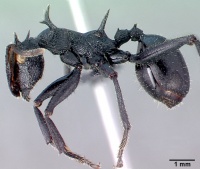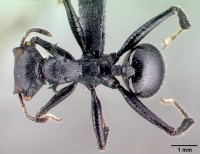Cephalotes alfaroi
| Cephalotes alfaroi | |
|---|---|
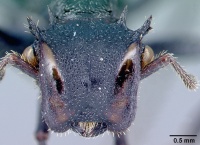
| |
| Scientific classification | |
| Kingdom: | Animalia |
| Phylum: | Arthropoda |
| Class: | Insecta |
| Order: | Hymenoptera |
| Family: | Formicidae |
| Subfamily: | Myrmicinae |
| Tribe: | Attini |
| Genus: | Cephalotes |
| Species: | C. alfaroi |
| Binomial name | |
| Cephalotes alfaroi (Emery, 1890) | |
Specimens have been collected in various moist tropical forests. Little else is known about the biology of Cephalotes alfaroi.
Identification
A member of the atratus clade characterised by the crenulate frontal carinae bearing clavate hairs (less so than in the sister species Cephalotes serraticeps, and differing from its sister species serraticeps by the longitudinally rugulose head and for the narrower and not laterally compressed first tarsomeres of the mid and hind legs. All the alfaroi specimens we have seen (including the syntypes) differ from serraticeps by the minute longitudinal rugulation of the head and of the mesosoma (properly described by Kempf, 1951), by the less clavate hairs over the frontal carinae and by the shape of the tarsomeres of the fore, mid and hind legs, less compressed, narrower and longer than in serraticeps. (de Andrade and Baroni Urbani 1999)
Keys including this Species
Distribution
Latitudinal Distribution Pattern
Latitudinal Range: 10.40126° to 8.6791°.
| North Temperate |
North Subtropical |
Tropical | South Subtropical |
South Temperate |
- Source: AntMaps
Distribution based on Regional Taxon Lists
Neotropical Region: Costa Rica (type locality), Panama.
Distribution based on AntMaps
Distribution based on AntWeb specimens
Check data from AntWeb
Countries Occupied
| Number of countries occupied by this species based on AntWiki Regional Taxon Lists. In general, fewer countries occupied indicates a narrower range, while more countries indicates a more widespread species. |

|
Estimated Abundance
| Relative abundance based on number of AntMaps records per species (this species within the purple bar). Fewer records (to the left) indicates a less abundant/encountered species while more records (to the right) indicates more abundant/encountered species. |

|
Biology
|
Castes
Worker
Images from AntWeb
 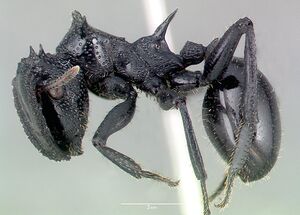 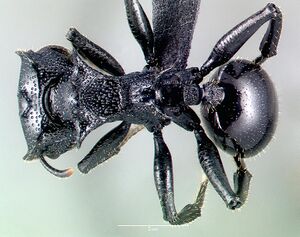 
| |
| Worker. Specimen code casent0040147. Photographer April Nobile, uploaded by California Academy of Sciences. | Owned by CAS, San Francisco, CA, USA. |
Nomenclature
The following information is derived from Barry Bolton's Online Catalogue of the Ants of the World.
- alfaroi. Cryptocerus alfaroi Emery, 1890b: 76 (s.w.) COSTA RICA.
- Type-material: syntype soldiers, syntype workers (numbers not stated).
- [Note: De Andrade & Baroni Urbani, 1999: 129, cite 1s, 3w syntypes (1s, 1w MHNG, 2w MSNG).]
- Type-locality: Costa Rica: Alajuela, 1889 (A. Alfaro).
- [Note: Emery, 1894k: 59, cites the type-locality as Jiménez, but De Andrade & Baroni Urbani, 1999: 129, retain the original description locality of Alajuela.]
- Type-depository: MHNG, MSNG.
- [Also described as new by Emery, 1894k: 59.]
- Wheeler, G.C. & Wheeler, J. 1983: 607 (l.).
- Combination in Cephalotes: Emery, 1914c: 39.
- Junior synonym of serraticeps: Kempf, 1963c: 437; Kempf, 1972a: 76; Bolton, 1995b: 140.
- Status as species: Dalla Torre, 1893: 140; Forel, 1899c: 48; Emery, 1914c: 39; Santschi, 1920f: 149 (in key); Emery, 1924d: 303; Kempf, 1951: 112 (redescription); De Andrade & Baroni Urbani, 1999: 129 (redescription).
- Distribution: Costa Rica, Panama.
Unless otherwise noted the text for the remainder of this section is reported from the publication that includes the original description.
Description
Worker
Kempf (1951) - Length 10.0 mm. Median head length 2.24 mm. Weber's length of thorax 3 . 1 7 mm. Similar to the major worker, from which it differs in the following features: Frontal carinae p artly semi-transparent, fuscous-ferruginous, converging in front, lateral border straight, preatly upturned. Each occipital angle with a pair of triangular spines, the anterior spine with a minute tooth arising from the base, projecting outward. Occiput continuous with vertex , not truncated, the pair of teeth on vertex obsolete. Integument subopaque, more sharply punctured and finely longitudinally rugulose caudad. Thorax subopaque, longitudinally areolate-rugose above and laterally. Scapular spines more slender, longer, acuminate, median teeth small, their bases transvese in the form of a crest. Spines of petiole more conspicuous. Sculpture of gaster sharper and coarser, distinctly longitudinally rugulose.
de Andrade and Baroni Urbani (1999) - Measurements (in mm) and indices: TL 8.40-11.46; HL 1.80-2.48; HW 2.20-2.88; EL 0.44-0.56; PW 1.76-2.70; PeW 0.47.0.62; PpW 0.60-0.80; HBaL 1.72-2.12; HBaW 0.35-0.47; CI 116.1-122.2; PI 106.7-125.0; PPeI 374.5-435.5; PPpI 280.0-360.0; HBaI 20.3-22.2.
Soldier
Kempf (1951) - Length 13 mm. Median head length 2.97 mm. Weber's length of thorax 4.15 mm. Black; the following dark ferruginous: tip of last funicular segment, apices of last tarsal segments, claws.
Head subfulgid, subquadrate, microscopically punctate, coarsely and sparsely foveolate. Mandibles reticulate-rugose, with a distinct apical and preapical tooth. Clypeur and frontal area vestigially set off. Frontal carinae crenulated, their sides moderately arcuate and slightly upturned. Vertex with a transversely located pair of blunt swellings. Occiput subtruncate mesad. Occipital angles with a rather large and obtuse posterior tooth, the anterior tooth scarcely distinct from the crenulated border of the frontal carinae. In lateral view three minute denticules project ventrad from the frontal carinae, in front of the eye. Eyes beneath the antennal scrobe. Maxillary palpi 5-segmented. A small but distinct tooth projecting from the sides of the head, somewhat above and behind the eyes. Scape incrassated distad, attenuate and subcylindrical proximad.
Thorax subopaque. Shoulders obtusely angulate. Dorsal face of pronotum inclined cephalad, with two stout, rather acute median spines and a lateral, stout, more or less apically truncate scapular spine on each side, above and behind the shoulder. A minute tooth projecting distad from the anterior side of the scapular spine. Promesonotal suture distinct. Mesonotum moderately inclined caudad, flat, marginate laterad, its posterior corners marked by somewhat raised, blunt swellings. Mesoepinotal suture distinctly impressed. Basal face of epinotum somewhat inclined cephalad; about as long as wide, its sides immarginate, subequal in length to the declivous face. Lower mesopleura with an anterior tooth. Epinotal spines longer than basal face, divergent, somewhat upturned, subacuminate. Integument microscopically and densely punctate, sparsely foveolate. Middle portion of femora moderately incrassate, the upper face strongly marginate on the distal end. Tibiae prismatic. Middle and hind basi tarsus compressed and greatly flattened.
Petiole subopaque; subquadrate from above, its sides subparallel. Anterior face obliquely truncate. Anterior corner of dorsal face with a laterally projecting minute tooth. Integument finely and densely punctate, and sparsely foveolate. Postpetiole wider than long, with a pair of conspicuous recurved teeth above, on the anterior border. Ventral face with a distinctly ventrally projecting lobe. Sculpture as on petiolc. Densely foveolate-rugose.
Gaster subfulgid. First tergite and firts sternite microscopically and very shallowly punctate, almost smooth, fulgid, except the narrow posterior margin, which, as also the exposed portion of the remaining tergites and sternites, are more sharply punctured and transversely rugulose.
Most of the foveolae contain a thin, short, decumbent seta. Margin of frontal carinae with a row of somewhat clubbed setae within the crenulations, along their entire length. Mandibles, lowe rsurface of head, spines of thorax, postpetiole appendages and gaster above and below, with sparse, erect setae.
de Andrade and Baroni Urbani (1999) - Measurements (in mm) and indices: TL 12.62-13.02; HL 2.92-3.04; HW 3.52-3.60; EL 0.68; PW 3.20-3.32; PeW 0.74-0.84; PpW 0.87-0.92; HBaL 2.04-2.08; HBaW 0.52; CI 118.4-120.5; PI 106.0-112.5; PPeI 381.0-448.6; PPpI 347.8-381.6; HBaI 25.0-25.5.
Type Material
de Andrade and Baroni Urbani (1999) - Worker and soldier. Type locality: Alajuela (Costa Rica). Type material: two workers labelled "Alajuela, Alfaro" in Museo Civico di Storia Naturale, Genoa; one worker and one soldier with syntype label only, in Musee d'Histoire Naturelle Genève, examined.
References
- de Andrade, M. L.; Baroni Urbani, C. 1999. Diversity and adaptation in the ant genus Cephalotes, past and present. Stuttgarter Beitrage zur Naturkunde Series B (Geolgie and Palaontologie). 271:1-889. (page 129, Revived from synonymy)
- Borysenko, L.H. 2022. The male of the ant genus Rhopalothrix (Hymenoptera: Formicidae: Myrmicinae). Neotropical Entomology 51, 413–422 (doi:10.1007/s13744-022-00947-w).
- Cantone S. 2018. Winged Ants, The queen. Dichotomous key to genera of winged female ants in the World. The Wings of Ants: morphological and systematic relationships (self-published).
- Emery, C. 1890b. Voyage de M. E. Simon au Venezuela (Décembre 1887 - Avril 1888). Formicides. Ann. Soc. Entomol. Fr. (6)(10): 55-76 (page 76, soldier, worker described)
- Emery, C. 1914b. Cephalotes et Cryptocerus. Le type du genre Crematogaster. Ann. Soc. Entomol. Belg. 58: 37-39 (page 39, Combination in Cephalotes)
- Kempf, W. W. 1951. A taxonomic study on the ant tribe Cephalotini (Hymenoptera: Formicidae). Rev. Entomol. (Rio J.) 22: 1-244 (page 112, see also)
- Kempf, W. W. 1963c. Nota sinonímica acêrca de formigas da tribo Cephalotini (Hymenoptera, Formicidae). Rev. Bras. Biol. 23: 435-438 (page 437, Junior synonym of serraticeps)
- Oliveira, A.M., Powell, S., Feitosa, R.M. 2021. A taxonomic study of the Brazilian turtle ants (Formicidae: Myrmicinae: Cephalotes). Revista Brasileira de Entomologia 65, e20210028 (doi:10.1590/1806-9665-rbent-2021-0028).
- Pazmiño-Palomino, A., Troya, A. 2022. Ants of Ecuador: new species records for a megadiverse country in South America. Revista Brasileira de Entomologia 66(2):e20210089 (doi:10.1590/1806-9665-RBENT-2021-0089).
References based on Global Ant Biodiversity Informatics
- Emery C. 1890. Studii sulle formiche della fauna neotropica. Bull. Soc. Entomol. Ital. 22: 38-8
- Emery C. 1894. Estudios sobre las hormigas de Costa Rica. Anales del Museo Nacional de Costa Rica 1888-1889: 45-64.
- Fernández, F. and S. Sendoya. 2004. Lista de las hormigas neotropicales. Biota Colombiana Volume 5, Number 1.
- INBio Collection (via Gbif)
- Kempf W. W. 1951. A taxonomic study on the ant tribe Cephalotini (Hymenoptera: Formicidae). Revista de Entomologia (Rio de Janeiro) 22:1-244
- Kempf W. W. 1959. Insecta Amapaensia. - Hymenoptera: Formicidae. Studia Entomologica (n.s.)2: 209-218.
- Longino J. T., J. Coddington, and R. K. Colwell. 2002. The ant fauna of a tropical rain forest: estimating species richness three different ways. Ecology 83: 689-702.
- de Andrade, M.L. & C. Baroni Urbani. 1999. Diversity and Adaptation in the ant genus Cephalotes, past and present. Stuttgarter Beitrage zur Naturkunde Serie B 271. 893 pages, Stuttgart
